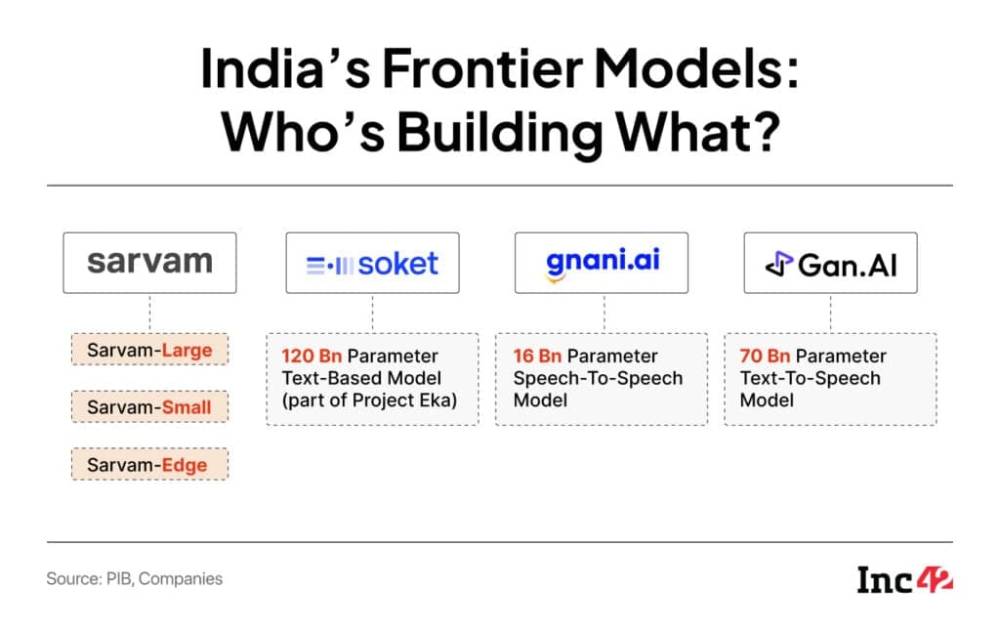
Ấn Độ đặt cược lớn vào LLM nội địa: Tham vọng xây dựng ChatGPT phiên bản “Made in India”
-
Ấn Độ đang triển khai tham vọng xây dựng các mô hình ngôn ngữ lớn (LLM) nội địa theo sáng kiến IndiaAI Mission trị giá 10.037 crore INR (1,2 tỷ USD), với mục tiêu bảo vệ chủ quyền dữ liệu và phục vụ đặc thù ngôn ngữ, văn hóa Ấn Độ.
-
4 startup đầu tiên được chọn gồm Sarvam AI, Soket AI, Gnani.ai và Gan.AI. Hơn 500 đề xuất khác đang chờ phê duyệt, tùy thuộc vào năng lực tính toán (GPU) hiện có.
-
Sarvam AI đã ra mắt Sarvam-1 (2B tham số) và Sarvam-M (24B), đồng thời phát triển các phiên bản cho thiết bị di động và ứng dụng tương tác thời gian thực.
-
Soket AI đang xây dựng mô hình mã nguồn mở 120B tham số; bản 7B sẽ ra mắt sau 6 tháng. Gnani.ai phát triển mô hình Voice AI 16B. Gan.AI tập trung vào mô hình đa ngôn ngữ 70B dành cho text-to-speech siêu thực.
-
Chính phủ cam kết hỗ trợ GPU, với năng lực hiện đạt 34.333 GPU (tăng 15.916 so với trước) nhưng nhiều GPU vẫn chưa đi vào hoạt động.
-
Các nhà sáng lập cảnh báo rằng chi phí huấn luyện cao và thiếu GPU tiên tiến là rào cản chính. Trong khi đó, vốn đầu tư mạo hiểm chủ yếu đổ vào ứng dụng AI, không phải mô hình nền tảng.
-
Pranav Mistry (TWO.AI) cho rằng vấn đề không chỉ là GPU mà còn là hạ tầng hỗ trợ: pipeline dữ liệu nhanh, quyền truy cập GPU linh hoạt và cấu hình huấn luyện tối ưu.
-
Thay vì cạnh tranh trực diện với ChatGPT hay LLaMA, Ấn Độ nên tập trung vào mô hình theo chiều dọc – AI chuyên biệt cho y tế, nông nghiệp, giáo dục, hành chính công – với ngữ cảnh và ngôn ngữ bản địa.
📌 Ấn Độ đang bước vào cuộc đua AI với mục tiêu xây dựng mô hình LLM chủ quyền, phục vụ ngôn ngữ và nhu cầu riêng. Dù thiếu GPU vẫn là rào cản lớn, 4 startup hàng đầu đã bắt đầu phát triển mô hình từ 2B đến 120B tham số. Nếu thực hiện thành công, Ấn Độ không chỉ sử dụng AI – mà còn định hình AI cho riêng mình, phục vụ từ bệnh viện nông thôn đến các hệ thống chính phủ.
https://inc42.com/features/inside-indias-high-stakes-bet-to-build-its-own-gpt/
Inside India’s High-Stakes Bet To Build Its Own GPT
-
With a collaborative push from the Centre and four generative AI startups — Sarvam AI, Soket AI, Gnani.AI, and Gan.AI — India is not far from launching its frontier AI models.
“Let the big boys in the (Silicon) Valley do it, spending billions of dollars. We will use it to create synthetic data, build small language models quickly, and train them using appropriate data…” Nilekani said last year.
Even as the country has selected its AI cavalry, questions that may come to mind are — what are we developing and how far have we come to live our Indic LLM dream? This is precisely what we will try to comprehend today.
So, What’s Being Served At India’s Big AI Feast?
- Sarvam-Large for advanced reasoning and generation
- Sarvam-Small for real-time interactive applications
- Sarvam-Edge for compact on-device tasks
However, one major aspect is clear — each of these companies will get computational support or access to graphics processing units (GPUs) for training their data. This would lower the cost of building LLMs.
While Gopalan did not reveal what else the company’s proposal to the IndiaAI Mission entailed, he said that the government is looking to solve two major problems as part of these collaborations — making GPUs more accessible and bringing down the cost of building LLMs.
India And GPUs: Are We Still Playing Catch Up?
In the current scheme of things, computational support becomes imperative to keep the development costs low, especially when VCs are more interested in funding AI applications and not foundational models due to their longer turnaround times and hefty investments.
Aakrit Vaish, former Haptik CEO and ex-advisor to the IndiaAI Mission, is wary of a situation where the Centre approves proposals from 12-13 companies and the existing compute capacity gets exhausted.
Why GPUs Are Still The Bottleneck For India?
“GPUs are as valuable as gold. With some top global companies like OpenAI taking up the largest chunks of GPU clusters, there has been a struggle to get GPUs in markets like India, particularly, the latest GPUs,” said Gnani.ai’s Gopalan.
“For a long time, there were many GPUs available in the market, but not enough companies to use them. Now, there has been a sudden spike in demand for building LLMs. Right now, the Indian government is trying to bridge that supply gap,” he said.

What’s Next For India’s Sovereign AI Efforts?
“We can’t afford to be passive users of someone else’s models; we need to lead. But leading doesn’t mean building just another massive LLM. Now, the real next opportunity lies in building the next generation of models — models that go beyond just text and voice. Think world models, systems that understand and reason, models aligned with sectors like agriculture, healthcare, education, governance — built for our realities, in our languages, with our context.”
Thảo luận
Follow Us
Tin phổ biến



